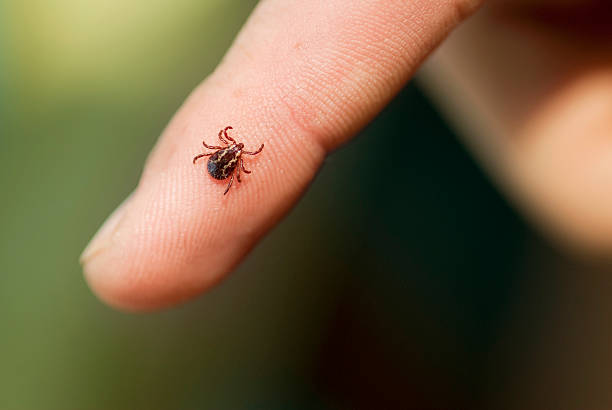It's tick season. How is Lyme infection sent? This is the very thing you really want to be aware.
With summer quick drawing closer, a large number of us are anticipating getting out into nature to partake in the natural air and delightful view.
Ends up, a few bugs have a similar thought.
The Venn graph between human open air action and nymphal (child) tick action has huge cross-over. This makes a powerful coincidence for a flood in Lyme sickness, which is reparable for a great many people.
An article distributed in The American Diary of Tropical Medication and Cleanliness, says that Lyme illness tops throughout the mid year months, when people are the most dynamic outside and when nymphal ticks begin to arise.
This is the very thing you really want to be aware of the secretive disease.
What is Lyme sickness?
Somebody might contract Lyme sickness in the event that they are nibbled by a tick. The side effects can wide-run. "Lyme infection is a tick-borne disease brought about by the microbes Borrelia burgdorferi. Ordinary side effects incorporate a skin rash, fever, migraine, and weariness. Most patients recuperate after the disease, however a few patients (around 10-20%) foster long haul side effects which incorporate weariness, body hurts, and trouble believing that are frequently incapacitating and life changing," says Dr. Brit Adler, a rheumatologist and specialist at Johns Hopkins Medication in Baltimore, Maryland, and the creator of an as of late distributed survey paper on the persistent side effects and entanglements related with Lyme illness.
Is Lyme infection reparable? This is the very thing you ought to realize about tick nibbles and side effects.
Is Lyme sickness infectious?
Lyme sickness isn't infectious. It doesn't spread from one individual to another. To become contaminated with the microorganisms, an individual unquestionable necessity been chomped by a tick that is tainted with the microbes. As per the CDC, as a rule, a tick should be connected for 36 to 48 hours or more before the Lyme sickness bacterium can be sent.
Does Lyme sickness disappear?
For the vast majority, a course of anti-infection agents (around 2 a month worth) will clear out the disease with no drawn out harm.
Nonetheless, for certain individuals, Lyme sickness might harm the heart, joints or sensory system.
At the point when left untreated, Lyme sickness can prompt a condition called "Lyme Carditis," which is the point at which the bacterium taints any piece of the heart, which can prompt serious entanglements.
At the point when Lyme microorganisms enter joint tissue, it can prompt joint enlarging and aggravation known as "Lyme Joint pain."
A few intense neurological inconveniences of a Lyme contamination incorporate aseptic meningitis, (irritation of the meninges, or the covering that safeguards your cerebrum and spinal rope) and different side effects like deadness, torment, shortcoming, facial paralysis/hang (loss of motion of the facial muscles), or visual unsettling influences.
Indeed, even after Lyme infection has been dealt with, enduring side effects might happen. According to adler, "A few patients with long haul side effects have a dysregulated autonomic sensory system, which is the piece of the sensory system that controls pulse and circulatory strain, processing, perspiring, temperature and understudy size. The vast majority don't deliberately ponder these essential capabilities, however when this piece of the sensory system doesn't work as expected it brings about different side effects including discombobulation while standing, shortcoming, cerebrum haze, and gastrointestinal side effects among numerous others."
What in all actuality does pressure do to the body? It very well may be more awful than what you understand.
For what reason do specialists not treat Lyme infection?
This is a convoluted inquiry. Lyme illness, in its constant structure, has become dubious lately - not on the grounds that Lyme sickness doesn't exist (it does), or that it can't cause long haul issues, (it can) but since some good natured elective medication centers might advance doubtful demonstrative testing or therapies.
Adler contends that these centers flourish on the grounds that customary clinical practices can abandon patients. "Elective medication facilities are filling a colossal neglected need for patient consideration that our clinical foundation has neglected to address," she makes sense of.
Adler adds that one justification behind this is the vague symptomatic devices for Lyme, "Lab testing for Lyme sickness is blemished and doctors have little preparation in how to decipher the outcomes. Diagnosing Erythema Migrans (the 'Bulls-Eye Rash') can likewise be trying for a local area doctor. Along these lines, a great deal of patients are misdiagnosed, which further adds to doctor's uneasiness."
Adler says this is the most puzzling issue around a "ongoing" Lyme or dysautonomia conclusion. "A colossal issue is that the patient test and labs are many times typical, so the determination is generally made in light of side effects… and it is a lot simpler to credit an extensive rundown of side effects to uneasiness or a mental problem than to an illness that we have no openness to."
It's critical to take note of that since you've been nibbled by a tick doesn't mean you'll get Lyme. Most ticks are not tainted with the infection causing bacterium, (albeit this can be district subordinate) and as referenced above, they need to lock onto your skin for a few days.
You can safeguard yourself from ticks and different bugs by wearing long sleeves and jeans, utilizing bug repellent, checking your skin consistently and showering subsequent to being outside. By playing it safe, you can ward the bugs off.



0 Comments